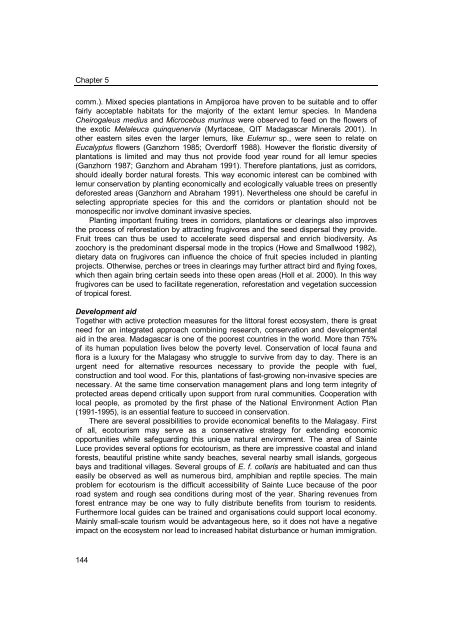Fruit-frugivore interactions in a Malagasy littoral forest - Universiteit ...
Fruit-frugivore interactions in a Malagasy littoral forest - Universiteit ...
Fruit-frugivore interactions in a Malagasy littoral forest - Universiteit ...
You also want an ePaper? Increase the reach of your titles
YUMPU automatically turns print PDFs into web optimized ePapers that Google loves.
Chapter 5<br />
comm.). Mixed species plantations <strong>in</strong> Ampijoroa have proven to be suitable and to offer<br />
fairly acceptable habitats for the majority of the extant lemur species. In Mandena<br />
Cheirogaleus medius and Microcebus mur<strong>in</strong>us were observed to feed on the flowers of<br />
the exotic Melaleuca qu<strong>in</strong>quenervia (Myrtaceae, QIT Madagascar M<strong>in</strong>erals 2001). In<br />
other eastern sites even the larger lemurs, like Eulemur sp., were seen to relate on<br />
Eucalyptus flowers (Ganzhorn 1985; Overdorff 1988). However the floristic diversity of<br />
plantations is limited and may thus not provide food year round for all lemur species<br />
(Ganzhorn 1987; Ganzhorn and Abraham 1991). Therefore plantations, just as corridors,<br />
should ideally border natural <strong>forest</strong>s. This way economic <strong>in</strong>terest can be comb<strong>in</strong>ed with<br />
lemur conservation by plant<strong>in</strong>g economically and ecologically valuable trees on presently<br />
de<strong>forest</strong>ed areas (Ganzhorn and Abraham 1991). Nevertheless one should be careful <strong>in</strong><br />
select<strong>in</strong>g appropriate species for this and the corridors or plantation should not be<br />
monospecific nor <strong>in</strong>volve dom<strong>in</strong>ant <strong>in</strong>vasive species.<br />
Plant<strong>in</strong>g important fruit<strong>in</strong>g trees <strong>in</strong> corridors, plantations or clear<strong>in</strong>gs also improves<br />
the process of re<strong>forest</strong>ation by attract<strong>in</strong>g <strong>frugivore</strong>s and the seed dispersal they provide.<br />
<strong>Fruit</strong> trees can thus be used to accelerate seed dispersal and enrich biodiversity. As<br />
zoochory is the predom<strong>in</strong>ant dispersal mode <strong>in</strong> the tropics (Howe and Smallwood 1982),<br />
dietary data on <strong>frugivore</strong>s can <strong>in</strong>fluence the choice of fruit species <strong>in</strong>cluded <strong>in</strong> plant<strong>in</strong>g<br />
projects. Otherwise, perches or trees <strong>in</strong> clear<strong>in</strong>gs may further attract bird and fly<strong>in</strong>g foxes,<br />
which then aga<strong>in</strong> br<strong>in</strong>g certa<strong>in</strong> seeds <strong>in</strong>to these open areas (Holl et al. 2000). In this way<br />
<strong>frugivore</strong>s can be used to facilitate regeneration, re<strong>forest</strong>ation and vegetation succession<br />
of tropical <strong>forest</strong>.<br />
Development aid<br />
Together with active protection measures for the <strong>littoral</strong> <strong>forest</strong> ecosystem, there is great<br />
need for an <strong>in</strong>tegrated approach comb<strong>in</strong><strong>in</strong>g research, conservation and developmental<br />
aid <strong>in</strong> the area. Madagascar is one of the poorest countries <strong>in</strong> the world. More than 75%<br />
of its human population lives below the poverty level. Conservation of local fauna and<br />
flora is a luxury for the <strong>Malagasy</strong> who struggle to survive from day to day. There is an<br />
urgent need for alternative resources necessary to provide the people with fuel,<br />
construction and tool wood. For this, plantations of fast-grow<strong>in</strong>g non-<strong>in</strong>vasive species are<br />
necessary. At the same time conservation management plans and long term <strong>in</strong>tegrity of<br />
protected areas depend critically upon support from rural communities. Cooperation with<br />
local people, as promoted by the first phase of the National Environment Action Plan<br />
(1991-1995), is an essential feature to succeed <strong>in</strong> conservation.<br />
There are several possibilities to provide economical benefits to the <strong>Malagasy</strong>. First<br />
of all, ecotourism may serve as a conservative strategy for extend<strong>in</strong>g economic<br />
opportunities while safeguard<strong>in</strong>g this unique natural environment. The area of Sa<strong>in</strong>te<br />
Luce provides several options for ecotourism, as there are impressive coastal and <strong>in</strong>land<br />
<strong>forest</strong>s, beautiful prist<strong>in</strong>e white sandy beaches, several nearby small islands, gorgeous<br />
bays and traditional villages. Several groups of E. f. collaris are habituated and can thus<br />
easily be observed as well as numerous bird, amphibian and reptile species. The ma<strong>in</strong><br />
problem for ecotourism is the difficult accessibility of Sa<strong>in</strong>te Luce because of the poor<br />
road system and rough sea conditions dur<strong>in</strong>g most of the year. Shar<strong>in</strong>g revenues from<br />
<strong>forest</strong> entrance may be one way to fully distribute benefits from tourism to residents.<br />
Furthermore local guides can be tra<strong>in</strong>ed and organisations could support local economy.<br />
Ma<strong>in</strong>ly small-scale tourism would be advantageous here, so it does not have a negative<br />
impact on the ecosystem nor lead to <strong>in</strong>creased habitat disturbance or human immigration.<br />
144

















